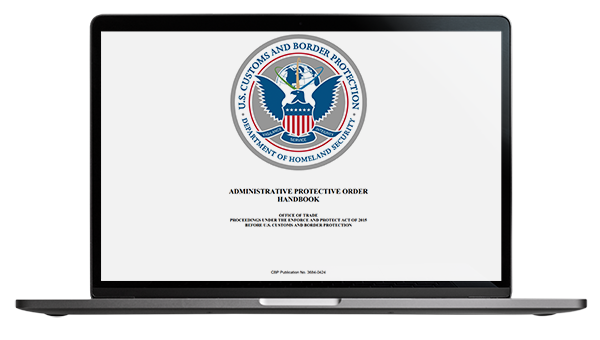U.S. Customs and Border Protection (CBP) has implemented a process that will allow certain authorized individuals to access business confidential information on the administrative record of an Enforce and Protect Act (EAPA) investigation under an Administrative Protective Order (APO).
Pursuant to its statutory and regulatory authority, CBP collects, generates, and reviews public and business confidential information during investigations, administrative reviews, and remand proceedings that it conducts in response to allegations of evasion of antidumping and countervailing duties. Previously, CBP only shared public summaries of business confidential information. However, CBP’s new process will allow authorized individuals to access the information subject to an APO in EAPA proceedings.
Administrative Protective Order (APO) Handbook
The APO handbook summarizes the CBP procedures for issuance of an administrative protective order (APO) in an EAPA proceeding and requirements to be employed to protect business confidential information subject to an APO.
Administrative Protective Order (APO) FAQs
An administrative protective order (APO) is a framework to protect and distribute business confidential information to authorized individuals. In this case, it is a mechanism to allow parties to an EAPA investigation to view business confidential information that is relevant to their case.
Before the APO, parties to an investigation could only view public documents and public versions of documents. After an APO is implemented, authorized individuals can view pertinent business confidential information.
CBP is implementing the APO process as a result of the U.S. Court of Appeals for the Federal Circuit’s decision in Royal Brush Manufacturing Inc. v. United States. The decision states that CBP must have a process to share business confidential information with the parties to an EAPA investigation. Additionally, the original EAPA regulations did not include any form of APO or mechanism for sharing business confidential information, but EAPA’s newly released Final Rule does.
An “eligible applicant” must be one of the following: 1) a U.S.-licensed attorney admitted to practice before the bar of a United States state or territory, who represents a party to the investigation, and is not employed as in-house counsel to a party to the investigation; or 2) a non-attorney staff member employed and/or retained by and working under the direction and supervision of a U.S.-licensed attorney who is authorized to receive business confidential information under the APO. Applicants must represent parties to the investigation in an active investigation/case.
An APO will be issued on day 90 after the initiation of an EAPA investigation. EAPA will notify parties to the investigation that an APO is placed on the administrative record and of the application deadline. An eligible applicant must file a letter with CBP that contains:
- a statement, under oath, by the applicant attesting to his/her/their status as an eligible applicant;
- a request for access to business confidential information under the APO;
- an agreement, under oath, to be bound by the terms of the APO; and
- an acknowledgement that a breach of the terms of the APO may subject the authorized recipient to sanctions imposed by CBP and/or other legal authorities.
All documents and information that are part of the administrative record (including any business confidential information being shared as part of the APO) will be shared through the EAPA Portal (also known as the EAPA Case Management System, or CMS). This is the same portal where you can access all pertinent information regarding the EAPA cases in which you are involved.
For detailed guidance, please review CBP’s Administrative Protective Order Handbook by visiting Enforce and Protect Act or contact the EAPA team at eapallegations@cbp.dhs.gov.



